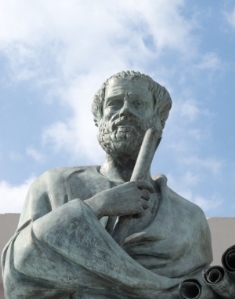 We had a running discussion within our office yesterday regarding the great teachers in our lives and why we’re thankful for them. I’ve been blessed enough that several came to my mind. Most of these exceptional moments were actually from my English teachers. This might explain why Writing, English, and Instruction are the core of my career. Simply put, those emotional connections (ethos, as it were) led me to my life.
We had a running discussion within our office yesterday regarding the great teachers in our lives and why we’re thankful for them. I’ve been blessed enough that several came to my mind. Most of these exceptional moments were actually from my English teachers. This might explain why Writing, English, and Instruction are the core of my career. Simply put, those emotional connections (ethos, as it were) led me to my life.
Every English composition instructor I know can recite the Aristotelian modes/appeals in his or her sleep. Better yet, we each remember every word of the ethos-pathos-logos lecture. In my time as a university instructor, my lesson plan looked something like this:
- Discuss audience: primary, secondary, tertiary
- Explain ethos, pathos and logos
- Discuss plays, TV shows, commercials, storylines that illustrate all of them in various degrees
We would talk about Aristotle and the great orators…the great teachers of their day…the original trainers. These instructors would gauge their audiences very closely, combining the perfect ratio of logic and emotion with credibility to teach, instruct, and persuade their audience. And because of that intuitive Aristotelian cocktail, it worked.
Today I got to thinking; I subconsciously apply this to instructional design every day. It’s in my dormant university-instructor portion of my brain; and though I’ve never actually waxed philosophical in a consultation, I know Aristotle is popping into my head all the time.
When conducting an ANSWER analysis (as in DesignJot™), we at Allen always address “A” for Audience first. We determine the best way to approach said audience, what their needs are, what their experiences are, how their culture affects them, etc. We then move on to address those needs, experiences, and culture through the right combination of innovation, knowledge, activities, interaction, engagement, and media. And we make an instructionally strategic call on each of those elements as to how much logos, ethos and pathos to bring in. In short, we make our own Aristotelian cocktail.
Ethos: We work with branding, messaging, look and feel, and exceptional graphic art and motion to establish credibility from the onset. The more impressed a learner is with the aesthetics of the course, the faster he or she puts away their cynicism and is willing to learn. Likewise, the better and stronger the content of the course, the more that initial ethos is perpetuated through the course and the more the learner continues to be engaged. Credibility is established.
Logos: Content is crucial here, as is instructional strategy. If our content is inaccurate, isn’t consistent on a particular level of technicality, if it’s not in a logical order, if our scenarios aren’t in a believable arc, the learner will question that credibility we took such pains to build.
Pathos: Scenarios are a vital element to learner engagement. If we create a probable situation for the learner to solve, where jobs or products are at stake, they want to save the day; they want to get it right; they want to learn the content. If engage them emotionally, they will apply the lesson well.
Like the great orators of old, we create for our clients’ learners the perfect blend of credibility, logic and personal application—just as my English teachers did as they guided me to my career. And it’s more than just rhetoric; it’s strategic instructional design. And it works.
Subscribe
Related Articles
Learner Experience Evolution
For learning leaders driving change in onboarding, leadership development, sales [...]
The Power Of Learner-Centered Compliance Training: Engaging Learners, Reducing Risk
This article was written and originally posted by Brandon Hall [...]
Finding the Right Training Company
Part 2: Creating Your Shortlist Finding the right training company [...]